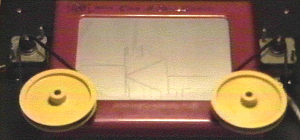
Perhaps the simplest example of this technique is an Etchasketch, whose knobs are connected to motors. Instead of the left hand controlling the horizontal motion, and the right the vertical-- the computer sends appropriate signals to the motor circuitry so that a predetermined path is followed.
A more technically sophisticated example is that of a pen plotter. Again, the motion of a tool (pen) is broken up into two axes-- X and Y, and controlled via motors. In this case, the option of tool active or inactive (pen down vs. up) has been added.
These are examples of linear motion control in 2 dimensions-- but the process can be generalized to other coordinate systems (cylindrical, spherical, etc.), and to 3 dimensions.
Tool path information is stored as a list of consecutive x,y coordinates (plus pen dn/up info for the plotter). Such a format is the structure of all "plot-files," and is readily output by drawing programs such as CorelDraw, Adobe Illustrator, and all CAD programs.